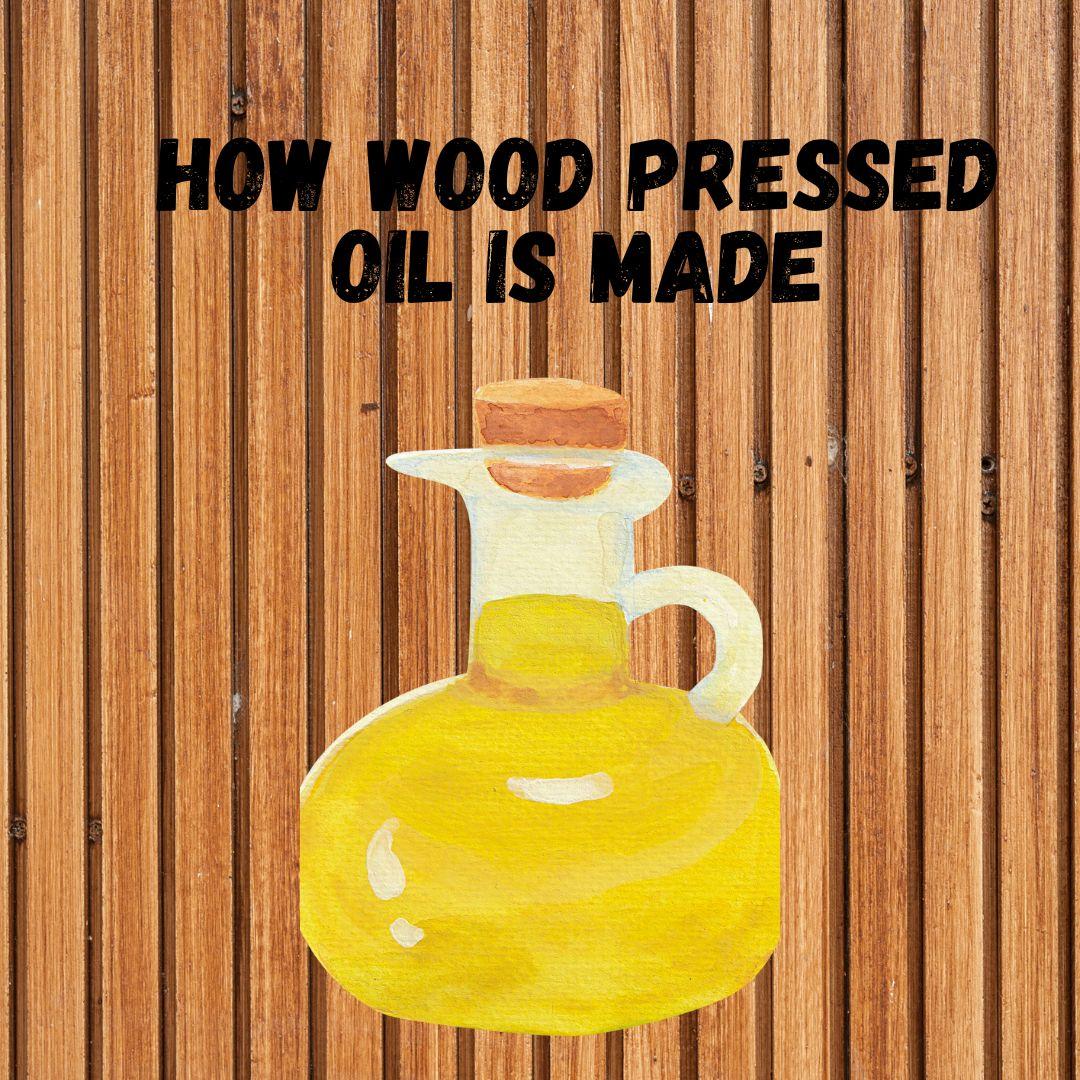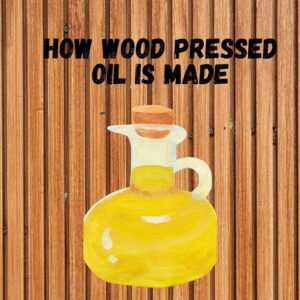
How Wood Pressed Oil Is Made: A Step-by-Step Guide
Wood pressed oil, also known as “ghani” or “kolhu” oil, is a traditional and artisanal method of extracting oil from seeds or nuts. This process has been cherished for centuries due to its ability to produce high-quality, unrefined oils with superior flavor, aroma, and nutritional properties. Below, we explore the detailed process of making wood pressed oil and why it stands out as a healthier and eco-friendly choice.

What Is Wood Pressed Oil?
Wood pressed oil refers to oils extracted using a wooden press mechanism. Unlike modern refined oils that are processed with heat and chemicals, wood pressed oils are made at low temperatures, preserving their natural nutrients, flavor, and aroma. This traditional method is labor-intensive but produces pure and authentic oil without compromising its quality.
Step-by-Step Process of Making Wood Pressed Oil
1. Selection of Raw Materials
The process begins with selecting high-quality seeds or nuts. Common sources include sesame seeds, peanuts, coconut, mustard seeds, and almonds. The quality of the raw material is crucial for producing flavorful and nutritious oil.
2. Cleaning and Preparation
The selected seeds or nuts undergo thorough cleaning to remove dirt, debris, or impurities. This step ensures that only clean raw materials are used for oil extraction. After cleaning, the seeds are dried naturally under the sun to reduce moisture content.
3. Grinding or Crushing
The cleaned and dried seeds are crushed into a coarse paste using traditional grinding stones or mills. This step breaks down the seeds and prepares them for pressing.
4. Pressing in Wooden Ghani
The ground seed paste is placed in a wooden press (ghani), typically made of hardwood like teak or rosewood. The wooden ghani consists of a cylindrical barrel with a rotating screw or piston mechanism.
5. Application of Pressure
Pressure is applied manually or mechanically using the wooden screw or piston to squeeze out the oil from the seed paste. The slow rotation ensures that the temperature remains below 50°C, preserving the oil’s nutrients and natural properties.
6. Separation of Oil
The extracted oil is separated from the solid residue (known as cake or meal) using filtration methods. Filtration involves passing the oil through fine mesh filters to remove any remaining particles or impurities.
7. Settling and Natural Filtration
The freshly extracted oil is allowed to settle naturally in containers to remove additional impurities. This step ensures that the final product is pure and clear.
8. Storage and Packaging
The purified wood pressed oil is stored in clean, airtight containers to protect it from light, air, and moisture. Proper storage helps preserve its freshness, flavor, and nutritional integrity before packaging into bottles or jars for sale.
Why Is Wood Pressed Oil Considered Superior?
Wood pressed oils are valued for their authenticity and health benefits because:
-
They retain essential nutrients like antioxidants (Vitamin E) and healthy fats.
-
They have a unique flavor and aroma that enhances dishes.
-
The slow extraction process ensures minimal nutrient loss compared to refined oils.
-
They are free from chemical additives or preservatives.
Benefits of Wood Pressed Oil
1. Nutritional Benefits
Wood pressed oils retain their natural vitamins (like Vitamin E), antioxidants, and fatty acids due to the low-temperature extraction process.
2. Health Benefits
-
Promotes heart health by reducing bad cholesterol (LDL).
-
Supports digestion due to its unrefined nature.
-
Strengthens immunity with natural antioxidants.
-
Helps maintain glowing skin and healthy hair when used topically.
3. Environmental Benefits
The traditional wood pressing method avoids chemical solvents and generates minimal waste, making it eco-friendly.
Common Types of Wood Pressed Oils
Here are some popular types of wood pressed oils along with their specific uses:
| Oil Type | Key Benefits |
|---|---|
| Sesame Oil | Rich in antioxidants; promotes heart health; ideal for skin care |
| Coconut Oil | Boosts metabolism; nourishes hair; improves digestion |
| Groundnut Oil | High in monounsaturated fats; enhances flavor in cooking |
| Mustard Oil | Supports cardiovascular health; adds a pungent taste to dishes |
How Does It Differ From Refined Oil?
| Feature | Wood Pressed Oils | Refined Oils |
|---|---|---|
| Extraction Process | Traditional wooden press | High heat & chemical solvents |
| Nutrients | Retained | Lost during processing |
| Flavor & Aroma | Natural & rich | Neutral |
| Health Impact | Positive (cholesterol-lowering) | Often linked to obesity & inflammation |
Challenges in Making Wood Pressed Oil
While wood pressed oils offer numerous benefits, their production comes with challenges:
-
Labor Intensive: The process requires skill and expertise.
-
Low Yield: The output per unit of raw material is lower than modern methods.
-
Higher Cost: Due to manual labor and limited production capacity.
Tips for Choosing Quality Wood Pressed Oils
-
Look for labels indicating “wood pressed” or “traditional ghani.”
-
Ensure the oil is stored in dark glass bottles to preserve its nutrients.
-
Opt for organic variants to avoid pesticides or additives.
-
Check for certifications ensuring purity standards.
Frequently Asked Questions
Here are some frequently asked questions to help clarify the process, benefits, and uses of wood pressed oil.
What is wood pressed oil?
Wood pressed oil is oil extracted from seeds or nuts using a traditional wooden press, known as a “ghani” or “kolhu.” This method preserves the oil’s natural nutrients, flavor, and aroma by avoiding high heat and chemical processing.
How is wood pressed oil made?
The process involves selecting high-quality seeds or nuts, cleaning and drying them, grinding them into a paste, and then pressing the paste in a wooden press. The oil is separated from the solid residue through filtration, allowed to settle, and then stored in airtight containers.
What types of seeds or nuts are commonly used for wood pressed oil?
Common sources for wood pressed oil include sesame seeds, groundnuts (peanuts), mustard seeds, and coconuts. Each type of seed or nut contributes its unique flavor and nutritional profile to the oil.
Are there health benefits associated with wood pressed oil?
Yes, wood pressed oils are rich in essential nutrients like antioxidants (such as Vitamin E) and healthy fats. They can promote heart health, support digestion, enhance immunity, and improve skin and hair health when used topically.
How does wood pressed oil differ from refined oil?
Wood pressed oils are extracted using traditional methods that retain their natural nutrients and flavors. In contrast, refined oils undergo high heat and chemical processing, which strips away many beneficial compounds and results in a neutral flavor.
Can I use wood pressed oil for cooking?
Yes, wood pressed oils can be used for cooking. They are particularly well-suited for traditional recipes and low to medium heat applications. However, they may not be ideal for high-temperature frying due to their lower smoke points.
How should I store wood pressed oil?
Store wood pressed oils in a cool, dark place away from direct sunlight and heat sources. Keeping them in dark glass bottles can help protect them from oxidation and extend their shelf life.
Can I use wood pressed oil on my skin or hair?
Yes, many wood pressed oils like coconut oil, sesame oil, and almond oil can be used topically for moisturizing skin or promoting hair health. Always perform a patch test first to check for any allergies or sensitivities.
What is the shelf life of wood pressed oil?
The shelf life of wood pressed oils varies depending on the type of oil and storage conditions. Generally, they should be used within 6 to 12 months after opening for optimal freshness. Always check for off smells or flavors before use.
Are all wood pressed oils organic?
Not all wood pressed oils are organic. If you prefer organic options, look for labels indicating that the oil is certified organic to ensure it was produced without synthetic pesticides or fertilizers.
Can I mix wood pressed oils with other types of oils?
Yes, you can mix wood pressed oils with other types of oils depending on your culinary needs. However, keep in mind that mixing may alter the flavor profile and nutritional benefits of each oil.
Is there a specific cuisine that typically uses wood pressed oils?
Wood pressed oils are commonly used in traditional Indian cooking (such as mustard oil) as well as Middle Eastern cuisines. They add authentic flavors to various dishes and are often preferred for their health benefits.
How do I choose quality wood pressed oil?
When selecting quality wood pressed oils:
-
Look for labels indicating “wood pressed” or “traditional ghani.”
-
Ensure the packaging is dark glass to protect against light.
-
Check for certifications ensuring purity standards.
-
Opt for organic variants when possible to avoid pesticides.
Are there any challenges associated with making wood pressed oil?
Yes, the production of wood pressed oils can be labor-intensive and may yield less output compared to modern extraction methods. Additionally, they can be more expensive due to manual labor involved in the process.
Conclusion
Wood pressed oils are more than just cooking ingredients—they represent tradition, authenticity, and health-conscious choices. By opting for wood pressed oils:
-
You enjoy nutrient-rich oils that promote overall wellness.
-
You support sustainable practices that minimize environmental impact.
-
You savor rich flavors that enhance your culinary experiences.
Switching to wood pressed oils can be a small yet impactful step toward healthier living while preserving cultural heritage!
